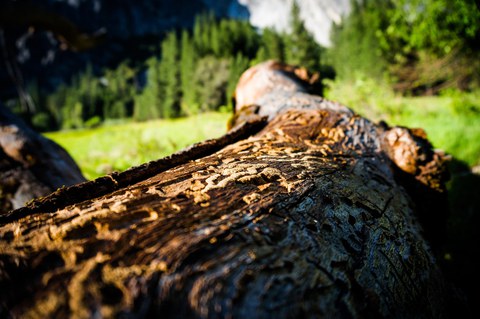Sep 01, 2020
Bamboozling the Bark Beetles
The forest is struggling to cope with the largest bark beetle plague in 70 years. While the trees are suffering due to the heat and the drought, the pests are proliferating rampantly in the warm weather: A pair of European spruce bark beetles, for example, can produce up to 30,000 offspring. Starting in 2004 and most recently in the joint project “bioProtect” (2015-2020), Professor Michael Müller, holder of the Chair of Forest Protection at TU Dresden, and his team have developed a method to regulate the beetles in an environmentally-friendly way. The project partners included the Department of Forest Zoology and Forest Conservation of the Georg-August-University Göttingen and the Ostdeutsche Gesellschaft für Forstplanung mbH.
The method involves treating raw wood, i.e. harvested wood, with substances that were originally extracted from the bark beetles’ pheromones. These messenger substances are not only used as a means of communication between the bark beetles themselves, they also attract predators, for example the ant beetle. In this case, these messenger substances are referred to as kairomones. If raw wood is treated with certain kairomones, it attracts, for example, ant beetles that eat bark beetles. The bark beetles themselves are not attracted to this. Professor Michael Müller discovered the principle back in 2004.
With “bioProtect”, the researchers have zealously developed the method further using so-called allochthonous kairomones from other locations. Put very simply: In deciduous forests, they used substances from coniferous forests, and in coniferous forests, they use substances from deciduous forests. This ecosystem exchange tricks the bark beetles. This is because the bark beetles that colonise deciduous trees do not recognise the pheromones of the conifer bark beetles - and vice versa. Many predators of the bark beetles, however, can identify the pheromones of several bark beetle species - both in deciduous and coniferous forests. Some of them do not care which species of beetle sends out these signals, as long as it’s a tasty bark beetle.
The foreign messenger substances are therefore selective: The enemies of the bark beetles are attracted by these substances, but other bark beetles are not. In the best-case scenario, the foreign substance acts as a deterrent. As larvae, the ant beetles eat the early stages of the bark beetle that burrow into the wood. These predatory beetles also “patrol” the bark, where they catch and eat approaching bark beetles. In this way, they can prevent or reduce the infestation.
The kairomones can be produced in the laboratory. Thanks to further developments in the “bioProtect” project, Müller is optimistic that this method will be marketable in three to four years. “The forest owners will no longer be buying insecticides in specialist shops, but natural substances that they can attach to stacks of raw wood”, he says. The substances do not have to be sprayed on, but can be applied in ampoules, for example. These can be removed again after use. “The bark beetle antagonists, such as the ant beetle, which are drawn in by the allochthonous kairomones, are native species. Even if the populations are influenced by the use of the messenger substances, they regulate themselves quickly and without harmful side effects”, says Müller. The allochthonous kairomones method ensures that the infestation does not get any worse: It protects harvested wood, reduces the breeding success of bark beetles in protected areas and keeps population densities low. Wood values are therefore preserved and living trees are supported in their defence. In order to curb mass reproduction, the trees have to regain their health. A healthy tree can defend itself against bark beetles.
Why do bark beetles have it so easy at the moment? How exactly do they damage the trees? Professor Michael Müller explains this in his new video: https://www.youtube.com/watch?v=-VkbP-wBfYM (to be embedded).
Further information:
MDR documentary „Tharandt – das Tal der Waldretter“ (Tharandt - Valley of the forest saviours) https://www.mdr.de/entdecke/tharandt-tal-der-waldretter-nachhaltige-forstwirtschaft-lehren100.html
Michael Müller as guest on the talk show SWR1 Leute: https://www.swr.de/swr1/bw/swr1leute/michael-mueller-104.html
Media enquiries:
Prof. Michael Müller
Tel.: +49 351 463-31280
